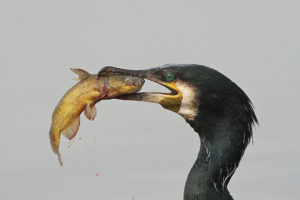We have much more to do and your continued support is needed now more than ever.
New Attempt to Muddy Clean Water Protections

The Trump Administration has just begun a two-step plan to remove protections from waters that have been safeguarded by the Clean Water Act for more than 40 years. In a process set in motion by an executive order earlier this year, Environmental Protection Agency (EPA) Administrator Scott Pruitt has taken the first step to repeal the widely-supported Clean Water Rule. The second step is replacing it with a new rule that dramatically rolls back the historic scope of the Clean Water Act.
This hasty process threatens critical fish and wildlife habitat as well as the drinking water sources for 1 in 3 Americans.
The 2015 Clean Water Rule restores protections to small streams and wetlands that flow downstream into our nation’s larger, iconic waters like Chesapeake Bay, Mississippi River, and the Great Lakes. These headwaters, rain-fed, and seasonal streams serve as spawning grounds, trout streams, and nesting habitat for the majority of North American waterfowl. These same waters are the source of drinking water of 117 million Americans.

The EPA and Army Corps of Engineers developed the Clean Water Rule after years of extensive public engagement and used the best available science and law to inform the final rule-making. During a seven month comment period, the EPA met with more than 400 stakeholders and received more than one million public comments on the rule, 87% of which were supportive. A wide range of stakeholders supported the rule – including 83% of hunters and anglers.
And now we have to do it all over again.
This time though, the Administration’s process intentionally provides very little opportunity for the many clean water stakeholders and affected communities to voice their support for a strong Clean Water Act to safeguard our drinking water and outdoor heritage. The public only has 30 days to provide input on this repeal.
February’s executive order directs the agencies to “consider” Justice Antonin Scalia’s opinion in a Supreme Court case when rewriting a rule that defines which waters are protected by the Clean Water Act. The majority of the Supreme Court – along with the Bush and Obama administrations and every federal court of appeals to consider it since – rejected this opinion as inconsistent with the Clean Water Act.
This process contradicts the law and science that is the basis for the Clean Water Act successes of the past four decades, crippling state and federal clean water initiatives.

Rolling back the Clean Water Act in this manner could mean the loss of protections for nearly 60% of streams in the lower 48 states that don’t flow year-round. It could threaten protections for the majority of the 110 million acres of wetlands in the continental United States. It could make things worse for low income communities and communities of color that already disproportionally lack access to clean drinking water. It could expose wetlands that many communities rely on for flood protection to the threat of destruction.

If these waters lose the protection afforded them by the Clean Water Act, it would have devastating impacts on fish, wildlife, and our robust outdoor recreation economy – not to mention the water quality of the streams that provide our drinking water.
Whether for drinking, swimming, fishing, boating, or brewing, we all need clean water. And for clean water, we need strong federal Clean Water Act safeguards, not haphazard rules that disregard the science, contradict the law, and ignore public input. We need to move forward, not be set back four decades.
![]() Add your voice today. Tell the EPA that you oppose any action to repeal the Clean Water Rule and efforts to diminish the common-sense protections that have safeguarded our nation’s waters for decades.
Add your voice today. Tell the EPA that you oppose any action to repeal the Clean Water Rule and efforts to diminish the common-sense protections that have safeguarded our nation’s waters for decades.






















